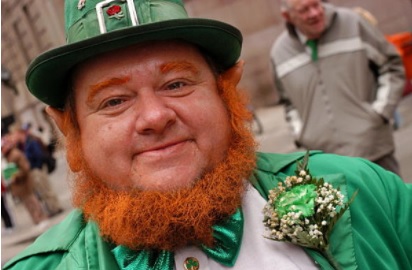A Brief History of the St. Patrick’s Day Leprechaun

Standing at about two to three feet tall, the Irish leprechaun is a mysterious creature that people often do not know much about. They are a well-known figure to represent the holiday St. Patrick’s Day, and they are also devious and rude.
March 15, 2019
When thinking of a leprechaun, most people will picture the tiny, smiling, green man on the front of a Lucky Charms cereal box. Leprechauns are actually not all smiles and rosy cheeks like Lucky Leprechaun, though. Irish fables portray these bite-sized creatures as ugly, mean and mischievous.
Leprechauns have gained popularity worldwide from being the famous face of St. Patrick’s Day, but originally, leprechauns were not even related to the Irish holiday. Instead, they grew into it over time. Theorists believe that the correlation between the two came from the fact that leprechauns are a symbol of good luck and fortune, which relates to the idea that Saint Patrick must have had good luck to have successfully escaped his Irish captors before he died.
When Saint Patrick was young, he was captured into slavery. In his autobiographical confession, he states that he was imprisoned for six years. He escaped and became a bishop in Ireland. After his death, he was named the patron saint of the country and received a holiday dedicated to him (Saint Patrick’s Day).
According to Irish legend, people who are lucky enough to find a leprechaun and capture him (or, in some stories, steal his magical ring, coin or amulet) can barter the leprechaun’s freedom for his treasure. Leprechauns are usually said to be able to grant the person three wishes, but dealing with a leprechaun can be an exciting yet tricky and risky proposition.
Leprechauns nowadays are depicted as wearing green attire, even though green is not the color they originally wore. The pint-sized men initially wore the color red, richly enlaced with gold, from head-to-toe. The only items of clothing that have remained the same for generations are their cocked hats, rounded shoes and gold belt buckles.
The idea of leprechauns, as well as people, wearing green on the holiday was not invented until the 20th century. From milkshakes to costumes, all items on this holiday converted to the color green. Green became used as a label for everything Irish from that point on.
As for the occupation of leprechauns, they were originally shoemakers who lived in underground caves or trees. They hid the money they made from their craft in pots hidden at the end of rainbows. Irish tales say that the reason they did this is because they were greedy and wanted profit only for themselves.
Leprechauns were not only shoemakers but also old male loners, which makes sense, since that type of fairy is so closely associated with shoemaking (a male job at the time). There are fascinating rumors about them being writers, farmers and even bankers inside of the fairy world too.
These miniature men are full of surprises and play an important role in the Irish culture. Though they can be rude and intolerable, supernatural followers around the globe find in them a source of fascination and believe that leprechauns are not mean and arrogant, but that they can be nice to a person if that person is nice to them.
More fun info:
http://mentalfloss.com/article/62173/15-lucky-things-you-probably-didnt-know-about-leprechauns
https://www.irishcentral.com/culture/entertainment/leprechauns-facts



